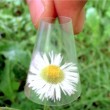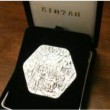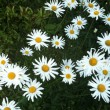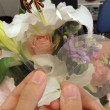“Learn the wood structure.”
Revise Q.In2-5 by Nogi 2020/010/12
Revise pictures in Section 3 by Nogi 2020/08/31
Add YouTube Video by Nogi 2020/08/03
Correct mistakes in Section 11 by Nogi 2020/07/02
Add QO-0 by Nogi 2020/05/28
Minor revised in Section 9 & 10 by Nogi 2020/05/24
Major revised by Nogi 2020/05/19
text by Nogi 2020/03/18
英語が得意じゃない学生さんへ
DeepL翻訳、Google translateなどウェブ翻訳サービスを最大限に活用して、下記の文章を理解してください。そして、解答は日本語で構いません。模範解答は英語で送りますけど、悪しからず。
Contents
Preface The Royal road in the cellulose nanofier
Section 1. X’mas “tree” or X’mas “wood”
Section 2. What’s that in a tree?
Section 3. We have two faces of “angel & devil”. How about wood ?
Section 4. Watch the trunk !
Section 5. What means “Baumkuchen”?
Section 6.“Wood cells” or “pulp fibers”
Section 7. Softwood & hardwood
Section 8. Wood: Anisotropic material
Intermission 1: Hierarchical structure in Wood
Section 9. Cell wall structures
Section 10. Birth of cellulose microfibril
Intermission 2: Stress-Strain curve
Section 11. Mechanical property in the cell wall
Section 12. The king dominates the world.
Overview. Play back the important questions.
Preface Wood structure is the royal road for the cellulose nanofiber research.
I believe you would like to be a top researcher in the cellulose nanofiber materials or science. What is the most important for it? Chemistry ? Electronics? No !! You must get the fruitful knowledge about the “cellulose nanofiber” itself.
To do so, what should you do ? It is the best way to understand “the cellulose microfibrils (セルロースミクロフィブリル) in wood cell walls (木材細胞壁)”, because it is the royal road!! However, you need many basic knowledge about wood or wood structure before understanding it. Therefore, we start the learning of wood & wood structure, and then “cell wall”, finally will reach the frontier knowledge in the cellulose nanofibers, I hope.
Section 1. X’mas “tree” or “wood”?
Do you know the difference in “tree” and “wood”?
From the oxford dictionary,
“Tree” is “a tall plant that can live a long time.”
“Wood” is “material that the trunk and branches of a tree are made of; this material when it is used to build or make things with, or as a fuel”.
Therefore, we often call “living or standing tree” instead of “tree”, and often call “lumber (板)” instead of “wood”.
From my own opinion, “tree” is “樹” and “wood” is “木 or 木材” in Japanese.
Q1-1. Which is “tree” and “wood” in the below pictures ?
(a)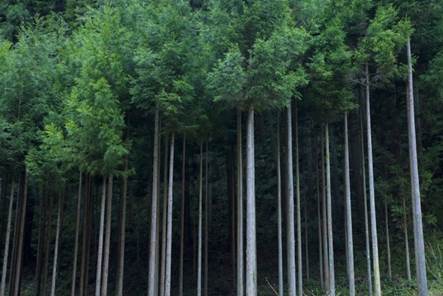 (b)
(b)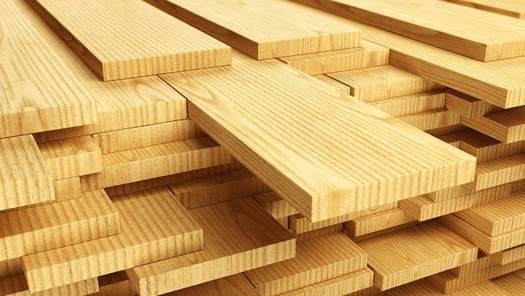
Q1-2. Take the “wood” & “tree” pictures by yourself, not pick up from the web site. Take a picture! When you send it, don’t forget to reduce the file size.
http://www.nogimasaya.com/favorite/reduce/
Section 2. What’s that in a tree?

We will find the below from your eyes.
“Crown (樹幹・じゅかん)”
is the top of a tree, where grows leaves or branches.
“Stem or Trunk (幹・みき)”
is the pipe connecting/supporting between roots and “branches and leaves”, where is the path of water and nutrients. They have main two roles. The first one is transportation of the water from the roots to the crown for their living, and the second one is supporting their weight for their standing.
“Root (根・ね)”
is the part of a tree that grows under the ground and takes in water and nutrients, and also support its body.
“Knot (節・ふし)”
is a hard round spot in a piece of wood where there was once a branch.
Q2. Answer the name of (a)-(d).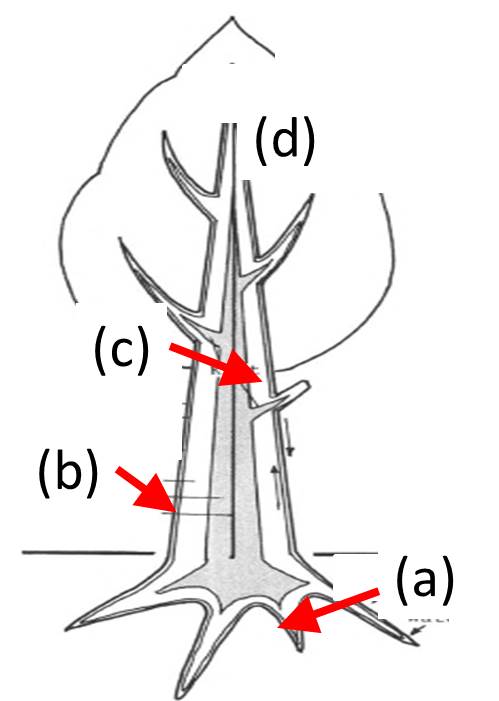
Section 3. We have two faces of “angel & devil. How about wood ?

We will find the below from your eyes.
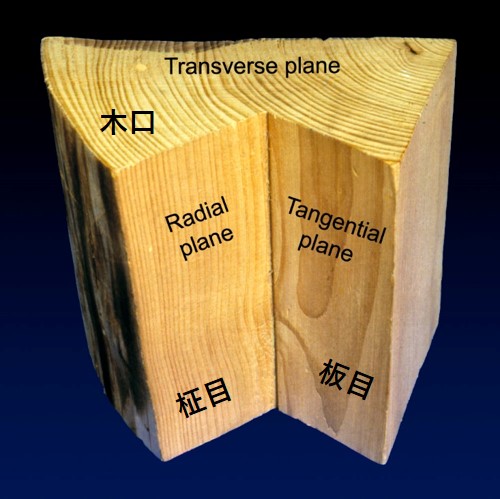
https://www.delta-intkey.com/citeswood/en/intro.htm 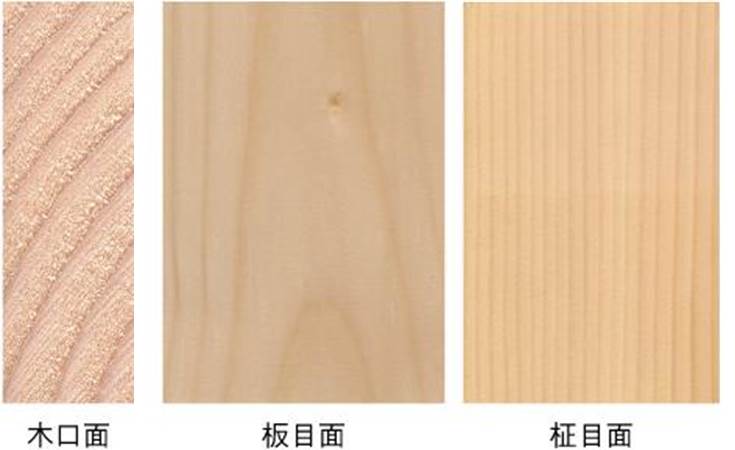
http://www.fpri.hro.or.jp/gijutsujoho/doumoku-db/doumoku/doumoku-index.htm
A wood block or lumber has 3 faces of transverse (木口・こぐち), radial (柾目・まさめ), and tangential (板目・いため) surface. These surfaces/directions are very important, because the wood physical properties are strongly dependent on them.
They also has another directions in 末口・すえくち (top side?) and 元口・もとくち (bottom side?). I don’t know the correct English name. When you see the knot (branch) direction or grain (木目) flow, you can image the original tree shape from the wood block/lumbers. The top/bottom direction are not so important, only for the maniac, I think.
Q3-1. Using the baumkuchen, take the three pictures of transverse (木口), radial (柾目), and tangential (板目) surface by yourself, not pick up from the web site. If you have some wood items, it is no problem that you will take their pictures, not baumkuchen.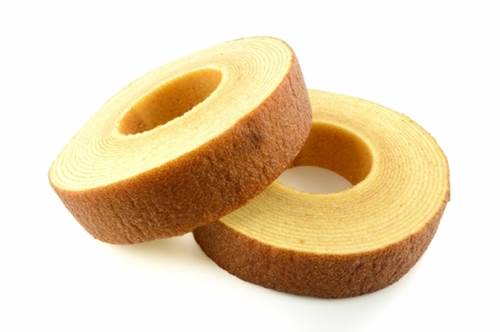
Q3-2. Do you have an angel face ? 🙂
Section 4. Watch the trunk !
 or
or 
We will find the below from your eyes or the magnifying glass.
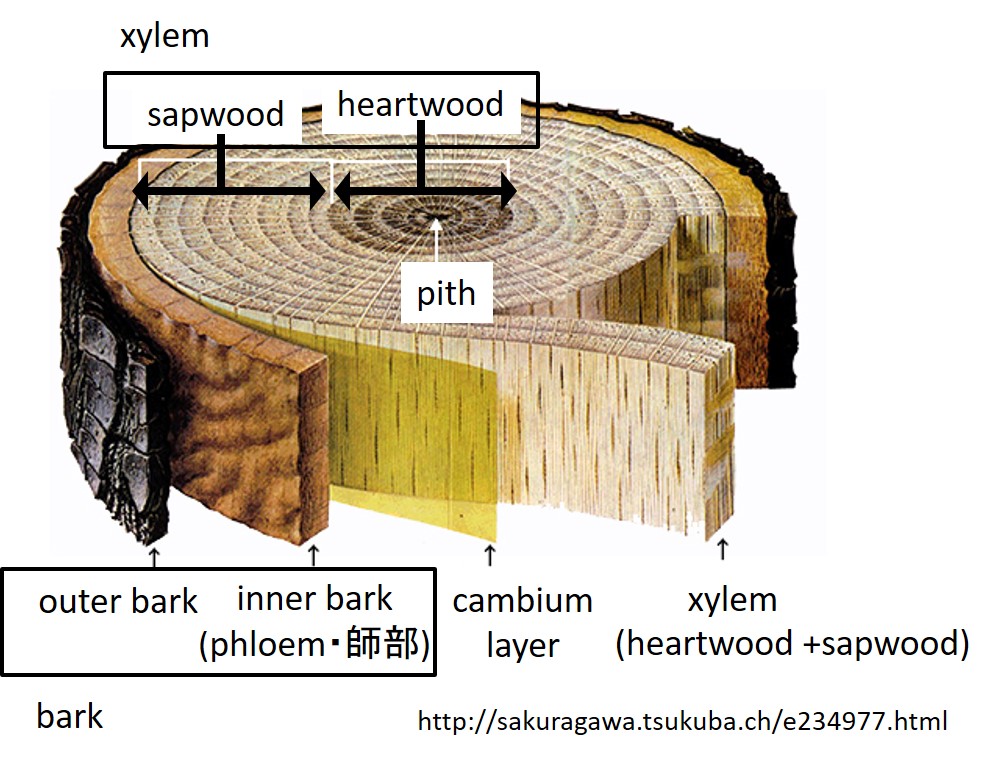
“Bark (樹皮・じゅひ)”
is the outermost layer of a tree trunk, which covers the xylem.
“Cambium layer (形成層・けいせいそう)”
is located between the bark and the xylem, which is the growing part of a tree trunk. It annually produces new cells of wood (xylem) and bark (phloem).
“Xylem (木部・もくぶ)”
is the material in plants that carries water and minerals upwards from the root. In plant, there are three parts of xylem, cambium, and phloem. In wood, the xylem is sapwood and heartwood, and the phloem is inner part of the bark.
“Sapwood (辺材・へんざい)”
is the soft younger outer layers of the wood of a tree, inside the bark.
Since sapwood acts as the tree’s pipeline for moving water up to the leaves, the water content of sapwood is generally higher than in heartwood. A tree’s sapwood is new wood; as new layers of sapwood are produced, the inner cells lose their vitality and become heartwood.
“Heartwood (心材・しんざい)”
is the hard older inner layers of the wood of a tree. All the cells in the heartwood are dead, but heartwood is as strong as steel. Its color is dark since it contains a considerable amount of extractives.
“Pith (髄・ずい)”
is presented at the center of the trunk. I have never heard its role… Moreover, due to the mechanical/geometrical theory (stress concentration), the pith is very easy to be cracked during its growth, drying, and lumbering.
In the summary, all the wood are generated from the cambium layer, which are alive. The parts generated toward the outside become the bark, which protect the inner parts. The ones toward the inside become the sapwood, in which some parts are dead, and then they become the heartwood (all the parts are dead) with the deposition of some extractives. Namely, the wood starts as sapwood, and then grows up to heartwood. So, thick logs (丸太) have larger heartwood area like this.
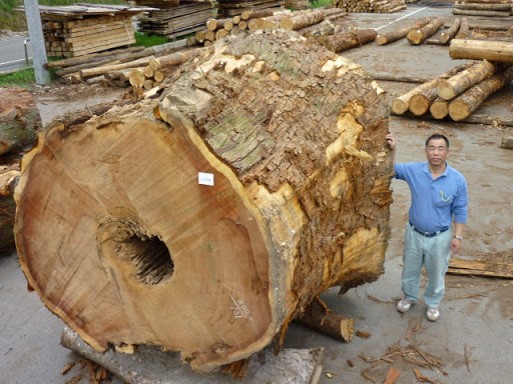
Q4. In all the questions, you must answer the term, not using alphabet.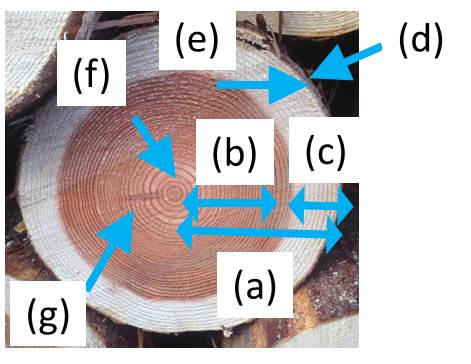
Q4-1. Answer the name of (a)-(g). [TIP] refer Section 2 for (g).
Q4-2. Answer the main role in (e). (pick up the sentence)
Q4-3. Among (b), (e), and (f), which is the living and dead area?
Q4-4. Among (b), (c), (e), and (f), sort the newest to oldest.
Q4-5. In (d) and (e), which is older?
Q4-6. Why is (b) dark color? (pick up the sentence)
Q4-7. Which is higher water content in (b) and (c)? And pick up the reason sentence.
Q4-8. Pick up the summary sentences, which explain all the structures.
Section 5. Do you know what means “Baumkuchen”?
“Baumkuchen” means “tree rings” in German. Do you know what is called it in English or Japanese? “Annual ring (年輪)” is not so correct..
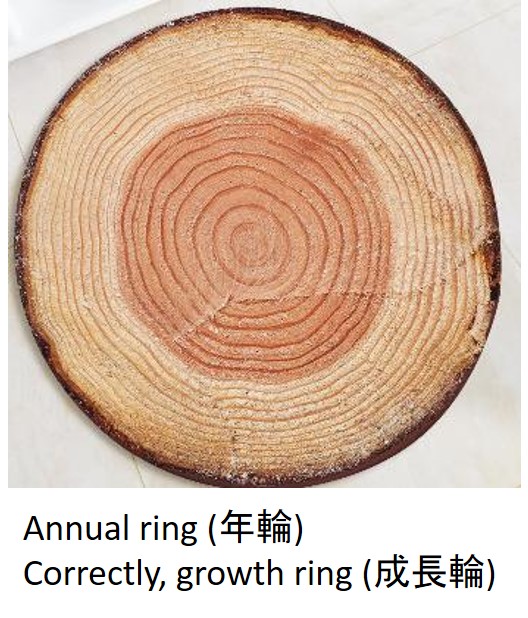
By your eyes, you observe the growth ring (成長輪), in a cross section of the stem of a woody plant, the increment of wood added during a single growth period. In temperate regions the growth period is usually one year, in which case the growth ring may be called an “annual ring (年輪)”. In tropical regions, wood generally has no annual rings, but sometimes contains false growth rings produced under different growth condition in wet and dry season.
Q.5-1 “Growth ring” is correct term, although “annual ring” is more famous term. Explain the reason why “annual ring ” is not so correct. (pick up the sentence)
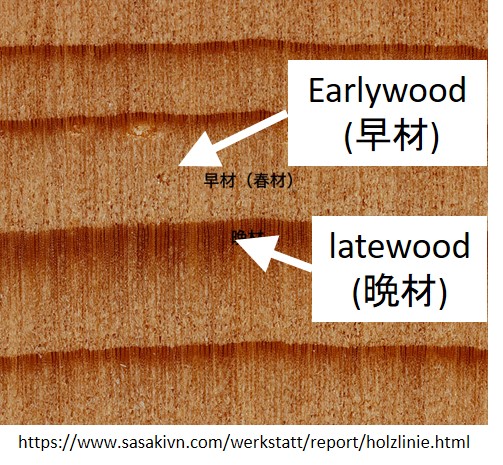

Using a magnifying glass, you will find that growth ring consists of lighter & darker area.
Lighter one is “earlywood (早材・そうざい)” and darker one is “latewood (晩材・ばんざい)”. Cambial activity has a certain periodicity, and active cell divisions and growth occur in the spring to summer season. Xylem produced in spring to early summer is called “earlywood”. Because these cells have relatively thin walls and large hollow (less dense), the earlywood is not so strong as the latewood. Xylem produced in late summer to autumn is called “latewood”. Because these cells have relatively thick walls and small hollow (more dense), the latewood is stronger than the earlywood.
Q.5-2 Pick up the sentences about the origin of name in “earlywood” and “latewood”, respectively.
Q.5-3 Pick up two sentences, which explain the morphological (not season) difference in “earlywood” and “latewood” cell.
Until here, it is the training (basic knowledge) for understandings of “cellulose microfibrils in the cell walls”. From here, you will meet the important keyword of “cell wall”. It is a start line. Let’s focus on our goal ! 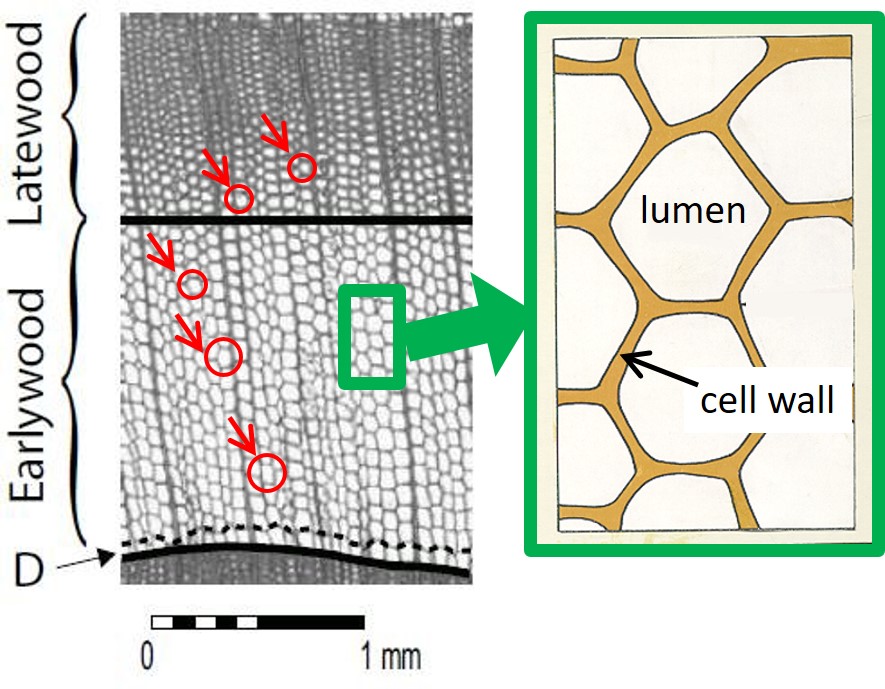
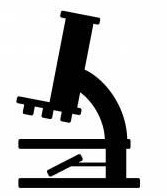
Left picture is originated by Stoffel (2005)
Right one from “http://www.geocities.ws/peforanger/palette.html”
When you observe using the optical microscopy, you will find many round/hexagonal shapes, which are “cell” (marked by red arrows in the left). The cell consist of the black line & white cavity area. The white ones are “lumen (内腔・ないこう), and the black ones are “cell walls (細胞壁)”. All the cell walls are generated in the cambium layer. Their different growth rate makes the pattern of “growth ring”.
Q.5-4 Answer the name of (a)-(c).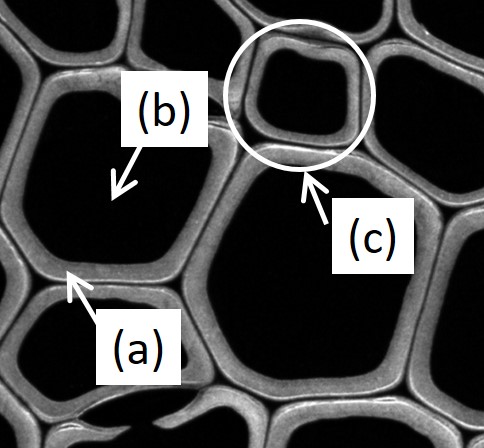
Q.5-5 When you see Stoffel’s picture, you find that light area in the earlywood and the darker area in the latewood. Answer the reason why latewood is darker than earlywood, using the terms of “cell walls” & “lumen” ? (Consider by yourself, referring Q.5-3.).
Section 6. “Wood Cell” or “pulp fibers”
There are many cell in the below picture, which was taken at the wood block from the edge view. The wood cell are often called as “pulp fibers (パルプ繊維)”, which are famous as the staring materials for paper.
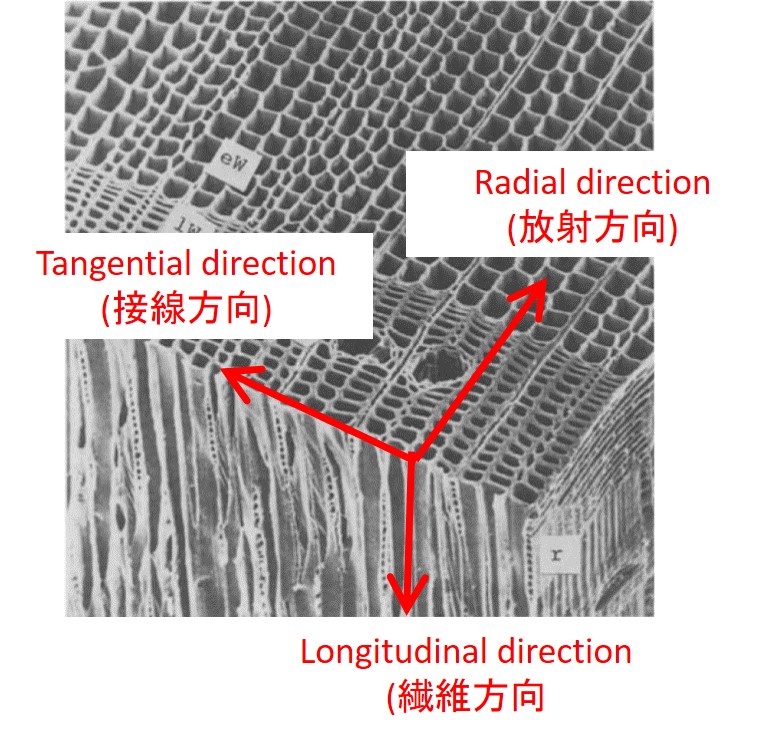 original picture by Saiki
original picture by Saiki
From the vertical view, the cells/ cell walls are still round/hexagonal shape, but they are the hollow cylinders, like straws. So, the wood block is the bundle of hollow cylinders (straws), which sometimes calls “honeycomb structure”.

Honeycomb structures
Q.6-1 In Saiki’s SEM picture, we will meet the quite difference face, when you observe from the longitudinal (L), the radial (R), and the tangential (T) direction. Answer the terms in Kanji (漢字), respectively. [TIP] Section 3.
Q.6-2 Pick up the term, what kinds of structure the wood blocks have.
The honeycomb structure in wood is made from the bundle of cell walls.
How to combine the cell walls? What is the glue between them?
Wood consist of three chemical components of “cellulose”, “hemicellulose”, and “lignin”.
(Rough talking, 50% cellulose, 25% hemicellulose, and 25% lignin in the wood.)
Let’s see the lignin distribution at the cross section at the cell wall.
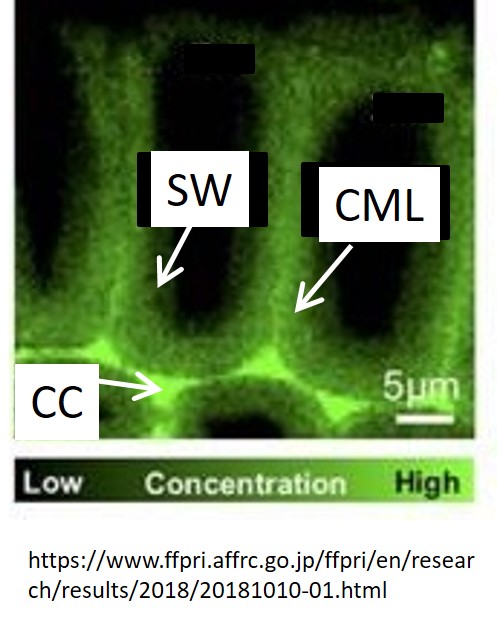
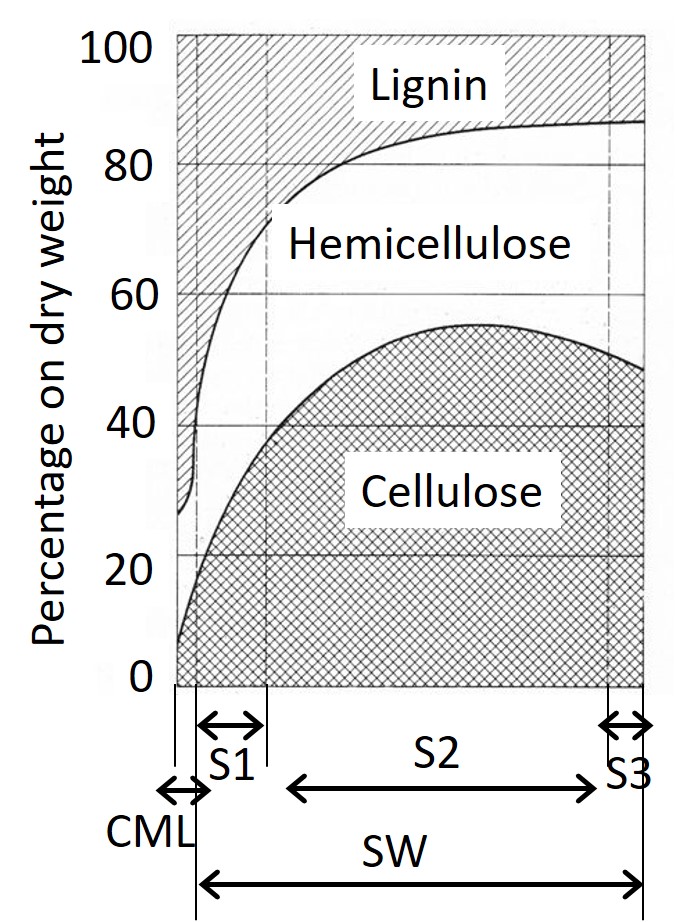 “CC” is the cell corner, “CML” is compound middle lamella, “SW” is the Secondary wall, “S1” is the S1 layer, “S2” is the S2 layer, and “S3” is the S3 layer. Now, you don’t know what is “Secondary wall”, “S1“, “S2“, and “S3“. We will explain them later. So, now, you understand they are one of cell walls.
“CC” is the cell corner, “CML” is compound middle lamella, “SW” is the Secondary wall, “S1” is the S1 layer, “S2” is the S2 layer, and “S3” is the S3 layer. Now, you don’t know what is “Secondary wall”, “S1“, “S2“, and “S3“. We will explain them later. So, now, you understand they are one of cell walls.
In the left picture, the green contrast shows the lignin concentration (Strong green is high lignin concentration). From the left picture, lignin is unevenly distributed in cell wall layers. Secondary wall (二次壁、SW) has a lignin distribution gradient from outside (high) to inner side (low). Highest lignin content is shown in the cell corner (CC), and compound middle lamella (複合細胞間層、CML). The right graph shows the the distribution of the principle chemical components within the various layers of the cell wall.
Q.6-3 Answer the three principle chemical composition in wood, and which is the most rich composition? (pick up sentence)
Q.6-4 Please explain the lignin distribution in the secondary wall. (pick up sentence)
Q.6-5 Do the cell walls contain the lignin, or not?
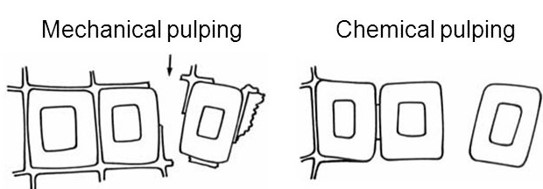
cited from “https://images.slideplayer.com/26/8450022/slides/slide_41.jpg”
Now you understand the high lignin distribution between the cell walls. The lignin acts as a glue/ adhesion between the cell walls. When you see the above pictures, you will understand the basic pulping process. Pulping process is the process of the producing the paper materials (pulp fibers) from the wood chips. When the lignin in the wood chips were removed by the chemical treatments, we get the pulp fibers (cell walls). In the mechanical pulp, the cell walls were separated by force without lignin removal. So obtained mechanical pulps are often brown color, like cardboard box (段ボール).
Q.6-6 How to combine the cell walls? (pick up a sentence)
Q.6-7 Answer how to produce the chemical and mechanical pulps. (pick up sentences).
Section 7. Softwood & hardwood
In tree, there is two types of “softwood (針葉樹)” and “hardwood (広葉樹)”. Softwoods come from gymnosperm trees which usually have needle leaves, while hardwoods come from angiosperm trees, which usually have broad leaves. In their growth, softwoods has a faster rate of growth than hardwoods.
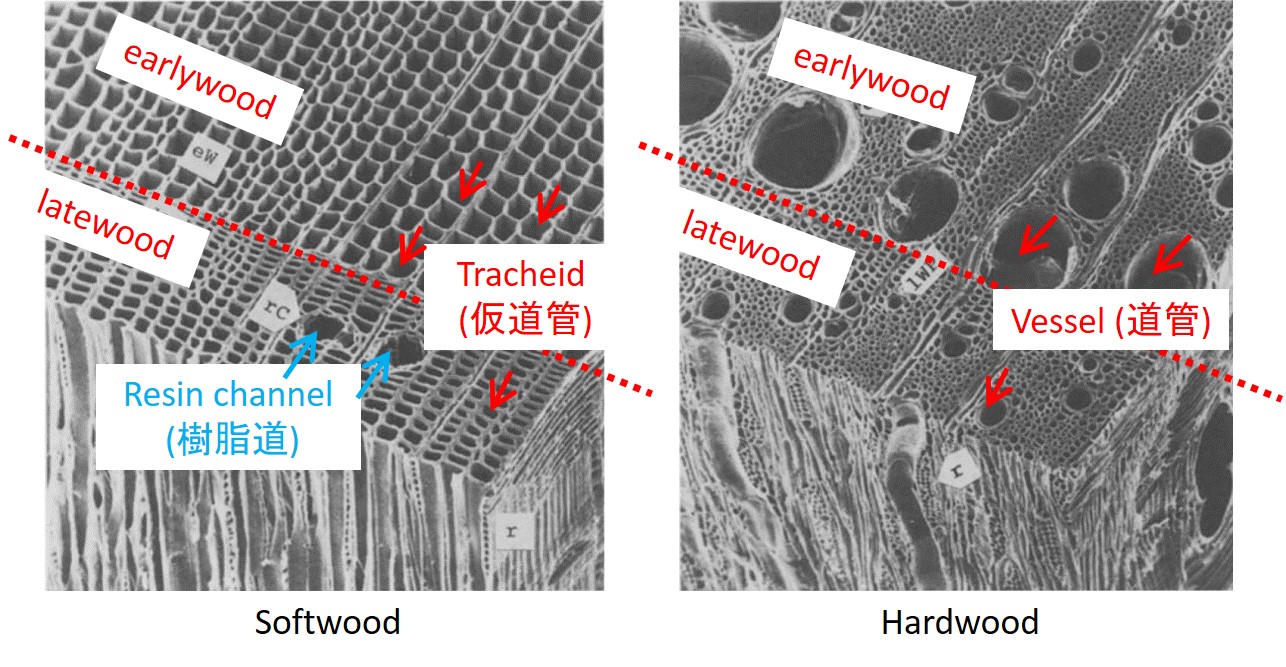 original picture by Saiki
original picture by Saiki
In softwoods and hardwoods, their cell walls (pulp fibres) are born in the cambium layer, which can produce various cell walls such as tracheid (仮道管・かどうかん), vessel (道管), ray tissues (放射組織).
In softwoods, about 95% of the constituent cells are long, fibrous tracheids which are arranged longitudinally in the stem. Tracheids serve to transport water from the rood to growing points and leaves; they have a mechanical function in supporting the tree. Hardwood often have more differentiated cells than softwoods (As one of the examples, there are many ray tissues). Instead of the tracheid, vessels serve to transport water, and wood fibers assume the mechanical function of supporting the tree. Simply, the cell walls in softwood are trachieds (仮道管・かどうかん), and that in hardwood are vessels (道管), ray tissues (放射組織) and others.
Q.7-1 Which is the softwood and hardwood in (a)-(f)?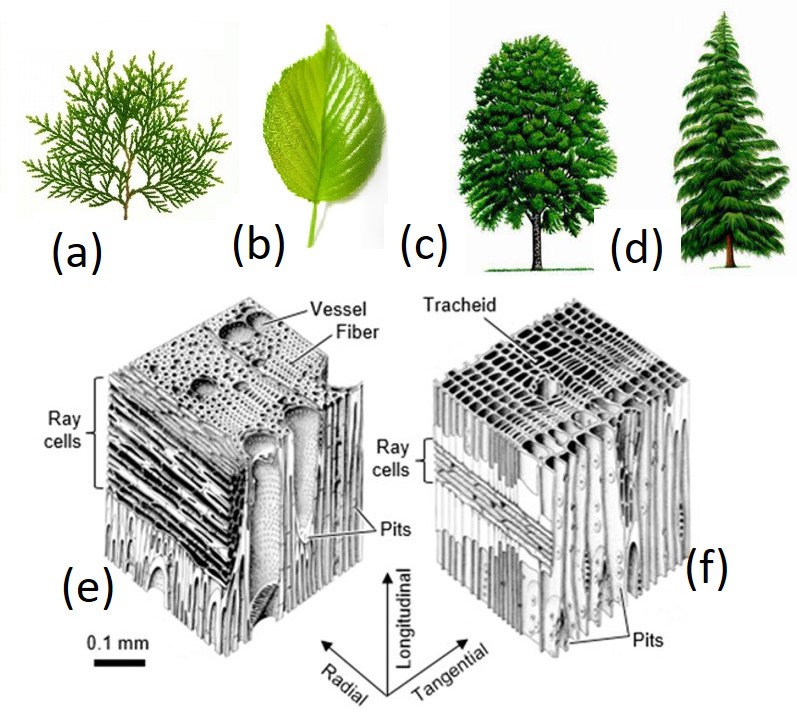
Q.7-2 What is the difference of cell walls in softwood and hardwood? (pick up simple sentence).
What is the difference in their applications? Softwood have a wide range of applications and are found in building components (e.g., windows, doors), furniture, medium-density fiberboard (MDF), and paper. Among them, the main their application is the building components because softwood is lower density than hardwood (lighter-weight & high strength materials). In contrast, hardwoods are more likely to be found in high-quality furniture, decks, flooring, and construction that needs to last, because higher density is the advantage in these applications.
Q.7-3 Answer the main application in softwood & hardwood, and their reason. (pick up sentences)
Q.7-4 Explain the reason why “softwood” is called as “SOFT”wood? There are no direct descriptions about it, however, you can find the answer from your deep reading in this section, I hope.
In pulp & paper making, woods are used for the materials of pulp fibers. Woods and cell walls consist of three chemical components of cellulose, hemicellulose, and lignin. Pulp fibers mainly consist of cellulose by removing of lignin. Pulp fibers from softwood and hardwood have different properties. Among them, the most famous one is the fiber size. Softwood pulp fiber is long and thin, while hardwood one is short and thick. Due to their morphology, the softwood pulp paper has higher strength than hardwood ones. However, at least in Japan (maybe worldwide), hardwood is the major pulp source.
Q.7-5 Explain the difference in softwood and hardwood pulp fibers. (pick up the sentences)
Section 8. Wood: Anisotropic material
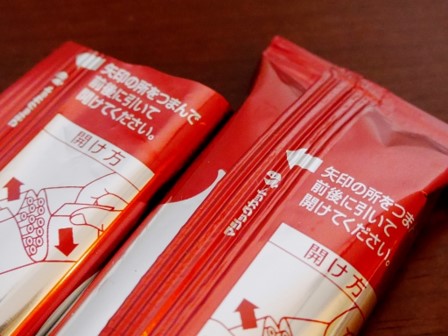
Most artificial materials, such as polymer, have the same physical properties in all the directions. Such properties are called as “isotropic”. In contrast, “anisotropic” is exhibiting properties with different values when measured in different directions. To enhance the anisotropy, polymer is sometimes stretched in the one-direction, which is the uniaxial oriented/deformation polymer. The oriented/anisotropic polymer bring us some advantages, one of them is easy to cut the film. (Cellophane film has also easy-cutting properties.)
One-directional materials or highly oriented materials are one of the anisotropic materials. Most researchers loves such materials. By the way, which is better isotropic and anisotropic? One-directional materials lovers may believe the anisotropic ones is better than the isotropic ones. However, the one-directional materials have the highest properties in only one direction, but the lowest ones in other directions. In contrast, the isotropic ones have better properties in all the directions. If you will be the materials, which will you want to be ??
Q.8-1 Explain the meaning of “anisotropic”. (pick up the sentence)
How about the wood blocks? Wood blocks are the natural-born anisotropic/oriented materials, due to the alignments of pulp fibers (cell walls). Please remember the role of the tree body in Section 2. The stem/trunk has two roles of water transportation and supporting their weight. What kind of alignment of cell walls (pulp fibers) is the best for the water transportation? Because the water go through the lumen in the cell wall, the cell walls are aligned in the vertical. What kind of alignments of cell walls (pulp fibers) is the best for the mechanical supporting? The cell walls are the hollow cylinder, like the straws. The straws are easy to deformed when the load are applied from the transverse, while they stand their shape when the load are applied from the vertical. Therefore, the cell walls are vertically aligned to support the tree. Do you understand that wood have already aligned by the nature gift ?
Q.8-2 Answer the two roles in tree stem/trunk. (pick up the sentence)
Q.8-3 Explain the reason why the vertical alignments in the lumen. (pick up the sentence.)
Q.8-4 Explain the reason why the vertical alignments in the cell walls.(pick up the sentence.)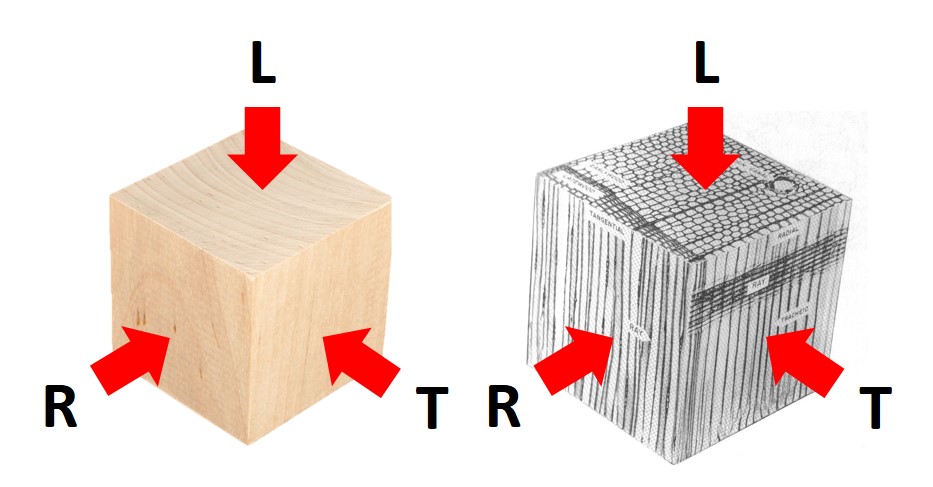
Q.8-5 Which is the fastest direction of L, R, and T, when the wood materials are used as the fluid devices for liquid/gas? Answer the reason, too. (consider by yourself)
Q.8-6 Which is the highest mechanical properties direction of L, R, and T, when wood materials are used as the structural objects? Answer the reason, too. (consider by yourself)
Q.8-7 Wood blocks have contradict property in the application of the fluid devices or structural objects. In high density wood block, which application is suitable ?
Intermission: Hierarchical structure in Wood
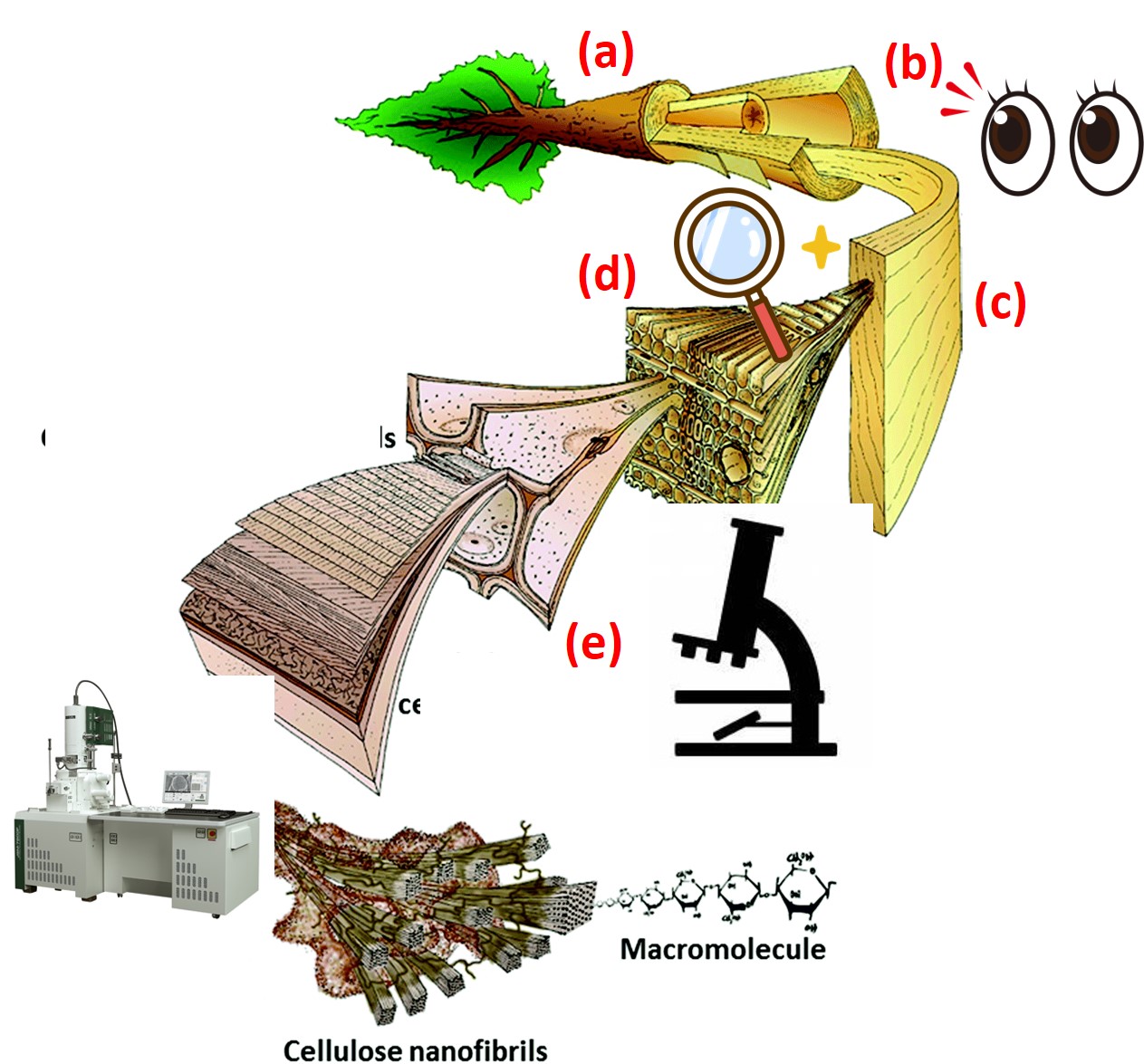
This is the famous illustration by Mark Harrington in 1996, which describes the hierarchical structure in wood. You have already understood from (a) to (e). (a) is the living tree, (b) is the wood, (c) is the lumber, (d) is the growth ring, and (e) is the cell wall.
You should understand its size level at each structures. (a)-(c) were observed by your eyes, (c) to (d) are by the magnifying glass, (d) to (e) are by optical microscope. From here, since the cell wall structure is very fine, we need the special microscopes of scanning electron microscope (SEM) or higher ones such as FE-SEM, TEM, AFM to observe the cell wall structure.
From these knowledge, you believe the cell wall is the important elements in tree. By the way, the cell wall is the minimum elements in the tree? Where is the cellulose nanofibers ?
Now, you will study “cellulose microfibrils in the cell wall”, which is the royal road in wood science. So, when you will get the perfect knowledge about it, you don’t need to learn more about “cellulose nanofibers”.
Before it, let’s have the review questions as follows..
Q.In1-1 Answer all the face names in the wood block (In English & JPN).
Q.In1-2 Pick up the summary sentences, which explain all the structures.
Q.In1-3 Pick up the term, what kinds of structure the wood blocks have.
Q.In1-4 Answer the three principle chemical composition in wood?
Q.In1-5 In the below picture, what is (a), (b), and the dark one (chemical name) ?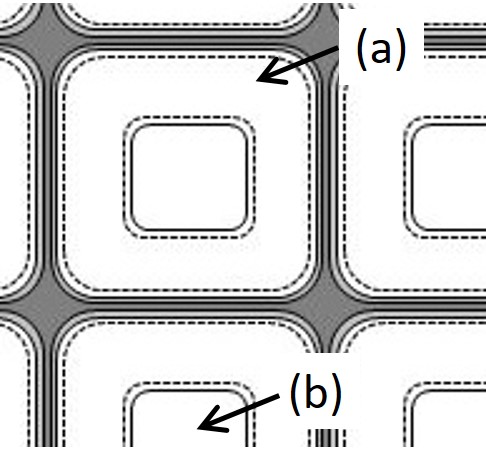
Q.In1-6 How to combine the cell walls? What is the glue between them? (Pick up a sentence)
Q.In1-7 Do the cell walls contain the lignin, or not?
Q.In1-8 In the wood block, which direction is the strongest ? Answer the reason, too.
Section 9. Cell wall structures
Now, you understand two results.
1) The cell wall is the important/fine elements in the wood structure.
2) The cell wall directions produce the wood anisotropy.
So, you will find the new questions about the cell wall structure, as follows.
3) In the cell walls, what is the important/fine element?
4) The cell wall itself are anisotropic? or isotropic?
Until here, the wood observation tells us the wood anisotropy and its hierarchy.
Therefore, from more precise observation in the cell wall, let’s understand the cell wall anisotropy and its hierarchy.
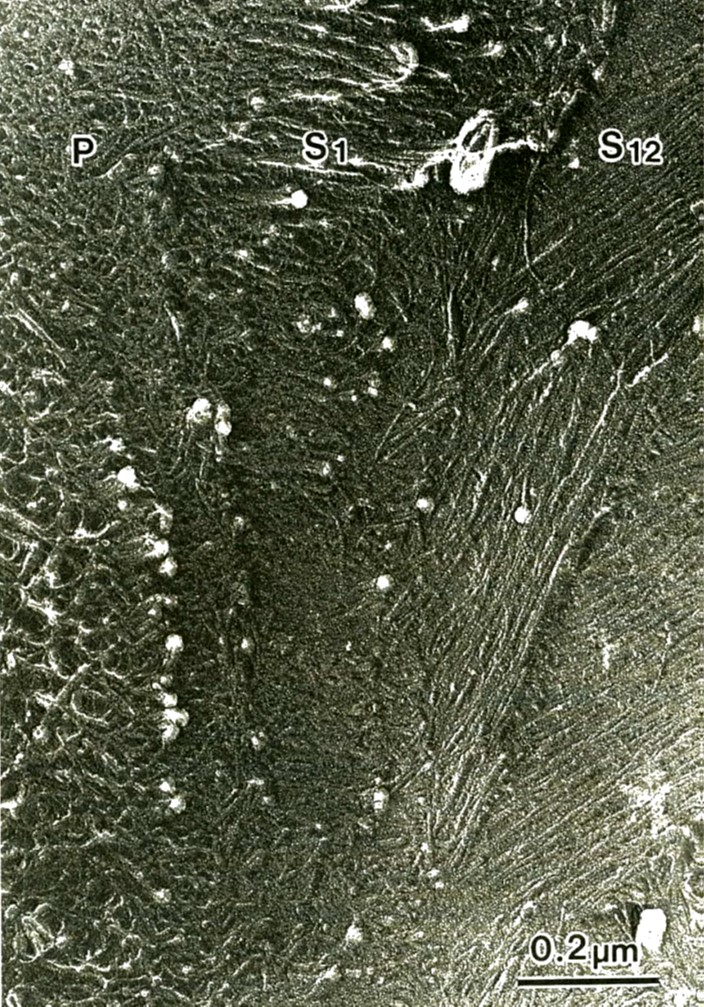
「木質の形成」p62より
This is the FE-SEM picture at the cell wall in eucalyptus.
In this picture, we find many nanofibers, which are the bundles of “cellulose microfibril (セルロースミクロフィブリル, sometime called “cellulose nanofibers”)”, on the cell wall. Moreover, we find that the cellulose micorfibrils are randomly oriented in the left part (P), they are transversely aligned in the middle part (S1), and then they are diagonally aligned in the part (S12, “S12” is the transition from “S1” to “S2“). So, the cell wall has also the anisotropic and hierarchical structure.
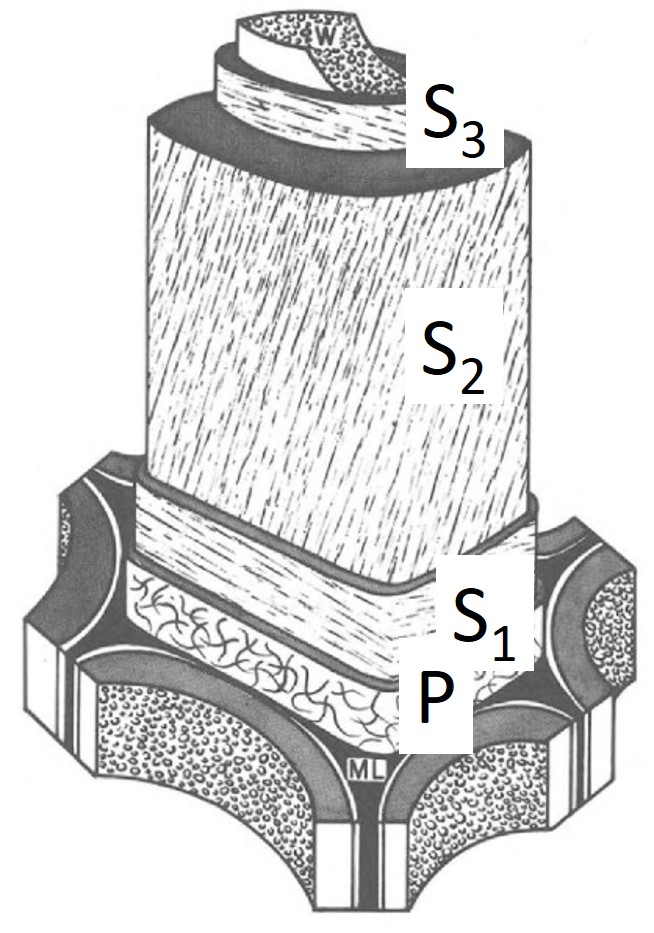 Simplified structure of a wood cell. (Originated by Kerr & Bailey in 1935, and then minor revised by Cote in 1967.)
Simplified structure of a wood cell. (Originated by Kerr & Bailey in 1935, and then minor revised by Cote in 1967.)
This is a generalized plan which applies to many cells in both softwoods and hardwoods, except in ray parenchyma (放射柔組織), in tension wood fibers (引張あて材の木繊維), in compression wood tracheids (圧縮あて材の仮道管) and so on. (Here, there are no introductions about these exceptions. Simply speaking, this model is for all the wood cells.) So, let’s start to understand the cell wall structure using the this famous model.
The cell walls contains several sub-layers, and are divided into primary and secondary walls, which is further divided into S1, S2, and S3 layers. Primary walls (一次壁, P層) are formed during cell elongation, while secondary walls (二次壁) are formed subsequently. Among these layers, middle layer of the secondary wall of S2 (S2層) is the most thick (approx. 80% of the thickness). Therefore, the S2 layer dominates the mechanical properties in the cell wall.
In this figure, the thin black lines are the bundles of cellulose microfibrils. The cellulose microfibrils are randomly oriented (network structure) in the primary walls, transversely aligned in the S1 layer, right handed spiral in the S2 layer, and transversely aligned again in the S3 layer. In the dominant layer of S2, the alignment makes an angle with the cell axis called the microfibril angle, “MFA (ミクロフィブリル傾角)”. (see the below). 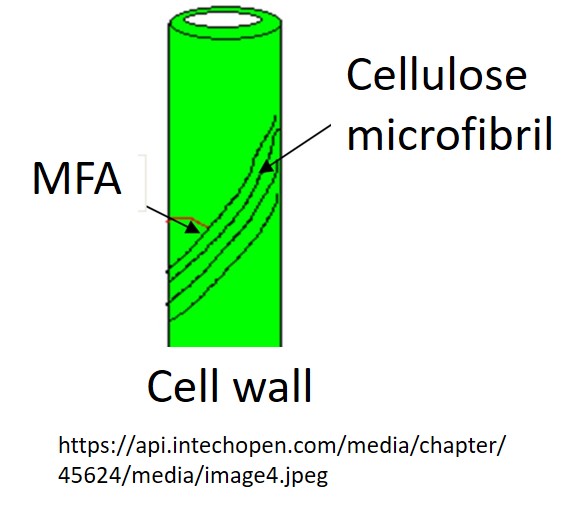
Q.9-1 What kinds of cell walls does this model explain in the Cote’s wood? (pick up a simple sentence)
Q.9-2 Answer the four layers in the cell wall.
Q.9-3 Answer the reason that S2 layer dominate the cell walls. (pick up a sentence)
Q.9-4 What are the black lines in the model?
Q.9-5 Answer the orientation in the four layers (pick up a sentence)
The microfibril angle, MFA is the angle between the cellulose fibrils and the longitudinal cell axis. MFAs in the normal wood (正常材) are around 20 degree (usually distributed in 5-30 degree). The tree usually stands in vertically, while sometimes stands with curving. The vertical standing tree has the normal wood, while the curved tree has the reaction wood (あて材), which is a tension wood (引張あて材) in angiosperm and reaction wood (圧縮あて材) in gymnosperm. MFAs in the reaction wood are much larger than normal wood (20 degree) to control the tree shape.
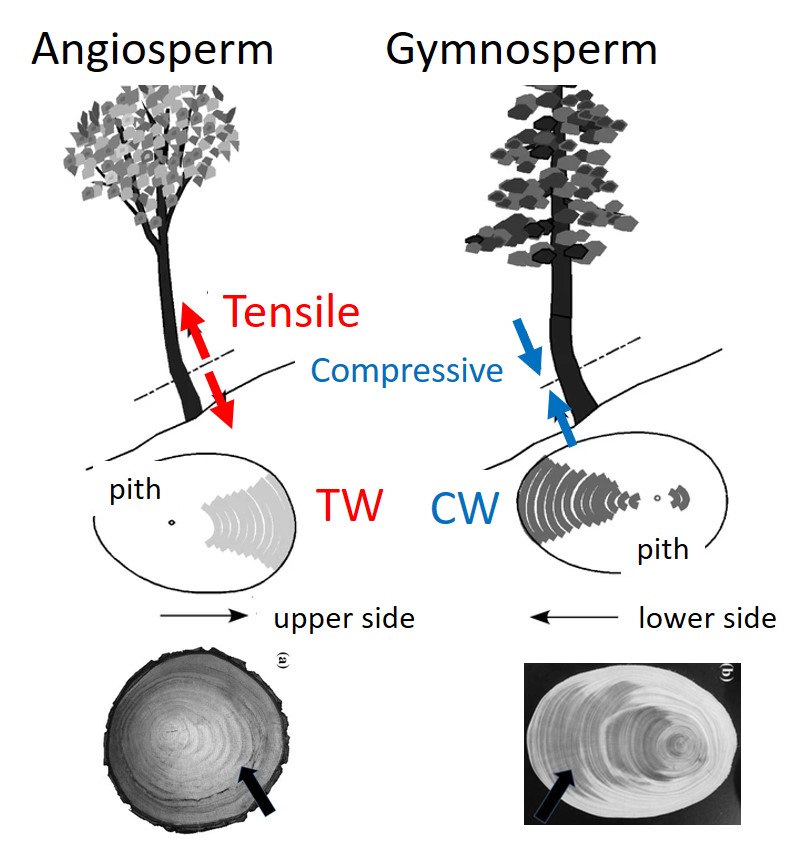 original from Gril in “Journal of wood science” (2017) 411-431.”TW” is tension wood, and “CW” is compression wood.
original from Gril in “Journal of wood science” (2017) 411-431.”TW” is tension wood, and “CW” is compression wood.
Q.9-6 What is the MFA? (pick up a sentence)
Q.9-7 How much is the MFAs in the normal wood?
The MFA is the representative parameter in the cell wall (pulp fibers) since the cellulose microfibrils are much stronger than other components of hemicellulose and lignin. As mentioned above, the wood/lumber’s mechanical properties are controlled by the wood cell walls. Moreover, the wood cell walls are dominated by the cellulose microfibrils. Therefore, the cellulose microfibrils are the king of the wood !!
Q.9-8 Answer the reason the cellulose microfbril or MFA is the king of the wood. (pick up a sentence)
Section 10. Birth of cellulose microfibril
When and where was the king born? Macroscopically, the cellulose microfibril was born every day in the cambium layer. (Don’t forget it is automatically produced every day, even when all the people has no activity. It is a fantastic nature work.) Microscopically, they are produced on the cell membrane by the terminal complexes (ターミナルコンプレックス: セルロース合成酵素複合体). After producing, they are surrounded by the hemicellulose, and then the lignin is deposited (沈着) into them.
Q.10-1 Answer where the cellulose microfibrils are born in the macro & microscopic, respectively. (pick up a sentence)
Q.10-2 What’s happened after producing? (Pick up a sentence).
They are the simplified models of the assembly process of cellulose microfibrils, hemicelluloses (mannanマンナン & xylanキシラン), and lignin. In these figures, the cellulose microfibrils in the cell walls are looking from diagonally (left), and from the top (right). The models were proposed by mainly FE-SEM observations in the middle layer of secondary wall of ginkgo (イチョウ) tracheid. At the FE-SEM observations in the cell walls, we always find around 15 nm wide fiber like strands, which are the bundle of cellulose microfibrils (their width is 2-5nm). So, in the models, the bundle of cellulose microfibrils are presented in blue. The bundle of cellulose microfibrils are strongly cross linked with the mannan (purple). (Someone suggested the mannan is never completely removed from the cellulose even by any chemical treatments.) Xylan, which is the other parts of hemicellulose, covered the manan and the cellulose microfibril bundles. Lignin (brown) are located between the hemicellulose surrounded cellulose microfibril bundles. The deposition of lignin into the bundles are called as “lignification (木化)”, which is to turn into wood or become woody through the formation. Lignification is a complex process occurring exclusively in higher plants; its main function is to strengthen the plant body.
Q.10-3 Answer the four components in Terashima’s model.
Q.10-4 Answer the width in the cellulose microfibril bundles when we observe the cell walls using the FE-SEM.
Q.10-5 What is strongly cross linked with the cellulose microfibril bundles? (pick up a sentence)
Q.10-6 Explain the lignin location in the cell wall.(pick up a sentence)
Q.10-7 What is the lignification? (pick up two sentences).
From these, you understand the generation sequence in the wood. At first, cellulose microfibrils were generated, and then hemicelluse, and finally lignin. Therefore, when when you want to dissolve the cellulose in the wood, you have to dissolve the lignin at first. Or when you want to chemically modify the cellulose in the wood chips, you have to remove the lignin firstly !!
Making the pure cellulose from the wood is impossible, because of the strong interaction between hemicelluose and cellulose. So, everyone accept that the wood cellulose containing with a small amount of hemicellulose is “cellulose”, although it is not 100% pure cellulose. In contrast, cellulose obtained from cotton or bacterial cellulose (Nata de coco) have higher puerility cellulose, because they don’t originally produce hemicellulose and lignin. Therefore, cellulose scientists like to use them as the experimental samples.
Q.10-8 Answer the generation sequence in the cell wall. (pick up the sentence)
Q.10-9 What should you do at first, when you manipulate the cellulose in the wood sample?
For more details…
The cellulose microfibrills are produced on the cell membrane by the terminal complexes. From the cellulose biosynthesis researches, the cellulose microfibrills are 4 nm width in the traditional, or 2-3 nm width in the latest research. However, from the cellulose microscopic research, the cellulose microfibrills are about 15 nm width. Nobody explains the gap is true or not, and where comes from. However, the concept of elementary fibril, that you sometimes meet in some articles or review articles, is old fashion & wrong concept at the present.
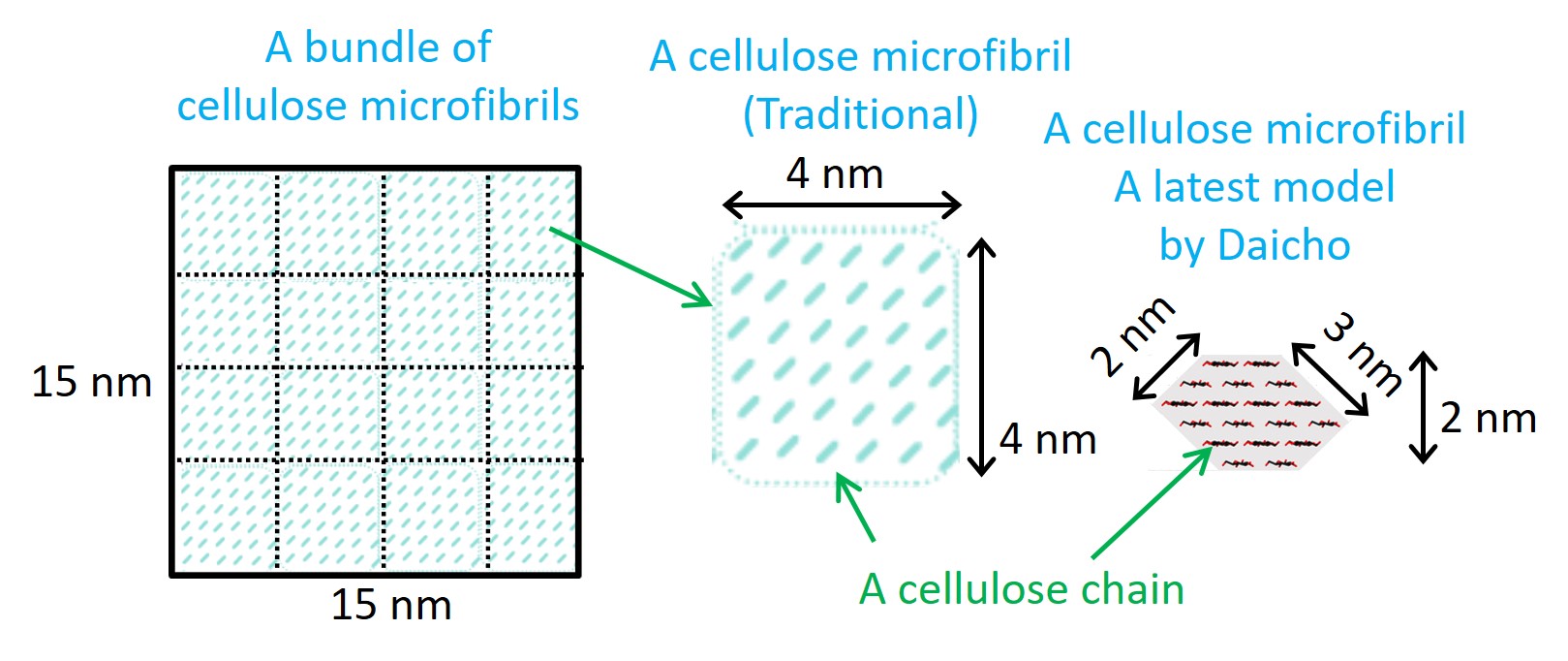
In the traditional model, a cellulose microfibril consist of 36 (6X6) cellulose chains. In the latest model, a cellulose microfibril consist of 18 cellulose chains. The cellulose microfibrils on the cellulose walls are much wider, so we believe they become the bundles.
In the conclusion,
there is no elementary fibrils.
the cellulose microfibrils just after produced are 2-4 nm wide.
the cellulose microfibrils in the cell walls are believe to be 15 nm wide.
Therefore, we believe that cellulose microfibrills are produced on the cell membrane by the terminal complexes, and then they become the bundle of cellulose microfibrills.
Q.10-10 How much width are the cellulose microfibrils just after produced?
Q.10-11 In the latest model, how many cellulose chains do one cellulose microfibril have??
Intermission 2: Stress-Strain curve
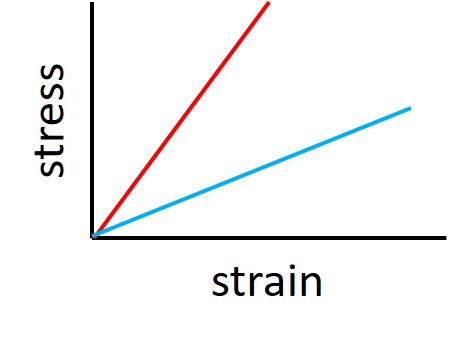
A stress–strain curve (応力ひずみ曲線、S-S curve) for a material gives the relationship between stress and strain. These curves reveal many of the properties of a material such as the Young’s modulus ヤング率 (Elastic modulus 弾性率) and strength.
Young’s modulus is a measure of the ability of a material to withstand changes in length when under lengthwise tension or compression. Simply, it is how difficult it is deformed. Young’s modulus is estimated from the applied stress divided by the strain. Simply, it is shown as the slope of the curve in the S-S curve.
The Young’s modulus and strength depend on the materials density. For example, Young’s modulus of polystyrene foam (発泡スチロール:ポリスチレンを発泡させた材料) is much lower than polystyrene block. Therefore, when we want to discuss the original properties of polystyrene, we will use the specific modulus such as “specific Young’s modulus (比ヤング率)” and “specific strength (比強度)”. The specific modulus is estimated from the modulus divided by the density of the objects.
Q.In2-1 What is the Young’s modulus simply? (pick up a sentence)
Q.In2-2 Where is the Young’s modulus shown simply? (pick up a sentence)
Q.In2-3 Which is more difficult to be deformed in the above graph? red or blue?
Q.In2-4 Answer the “specific Young’s modulus” or “specific strength”. (pick up a sentence)
Q.In2-5 We prepare the two materials of red and blue. The strength of the red one is 10, and the blue is 5. The density of the red one is 1, and the blue is 0.1. Which is higher strength materials, substantially/
intrinsically? Answer also the reason using the term and their values.
Q.In2-6 Answer the reason that nanopaper (ナノペーパー) has higher mechanical properties than the normal paper (普通紙), although the both consist of only the same cellulose nanofibers. (consider by yourself). [TIP] polystyrene foam and polystyrene block.
Section 11. Mechanical property in the cell wall
In section 8, the wood block anisotropy comes from the pulp fiber (cell wall) orientation.
At the top in Section 9, you get the two questions.
3) In the cell walls, what is the important/fine element?
4) The cell wall itself are anisotropic? or isotropic?
The cell wall consist of three components of cellulose microfibrils (framework), hemicellulose & lignin (matrix). The cellulose is the major components (50%), and moreover has much higher mechanical properties than hemicellulose and lignin. As mentioned in Section 9, the cell walls consist of many layers, and then S2 layer is thickest (80%) among them. Therefore, the cellulose microfibrils in S2 layer are the most important element in the cell wall.
Q.11-1 Answer the most important chemicals in the cell wall and the reason. (pick up a sentence)
Q.11-2 Answer the most important element in the cell wall and the reason. (pick up a sentence)
In Section 9, you understand there are microfibril alignment in the cell walls. So, you guess the cell wall itself seems to be anisotropic. Here, you learn the anisotropy in the cell walls.
Here, we set the two models of the S2 layer in the cell wall with small MFA (a) and large MFA (b). The black lines are the cellulose microfibrils, and the white is matrix (hemicellulose and lignin). The cell walls has the same size and chemical compositions, but has different MFA. When the same weight are put on these cell walls, the small MFA cell walls keep their shape, while the large MFA cell walls become shrink.
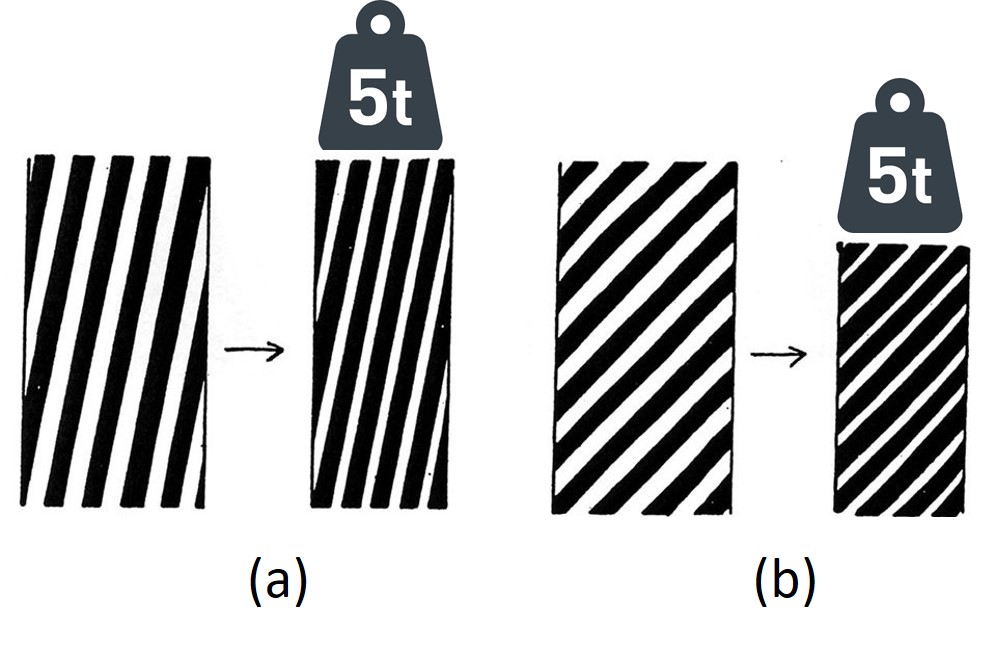
Q.11-3 What is the model in the above figure? (pick up some words)
Q.11-4 What do black & white ones present/mean? (pick up a sentence)
Q.11-5. Why Fig (b) becomes shorter than Fig (a) in spite of the same weight? (consider by yourself)
The below graph is the evidence for the above concept. This graph shows the S-S curves in wood pulp fibers with various MFAs. The values in the curves of 1, 12, 22, … 46 present the MFAs in S2 layers of each wood pulp fibers. As shown in this graph, the larger MFA pulps are easy to be elongated and the smaller MFA pulps are difficult to be deformed.
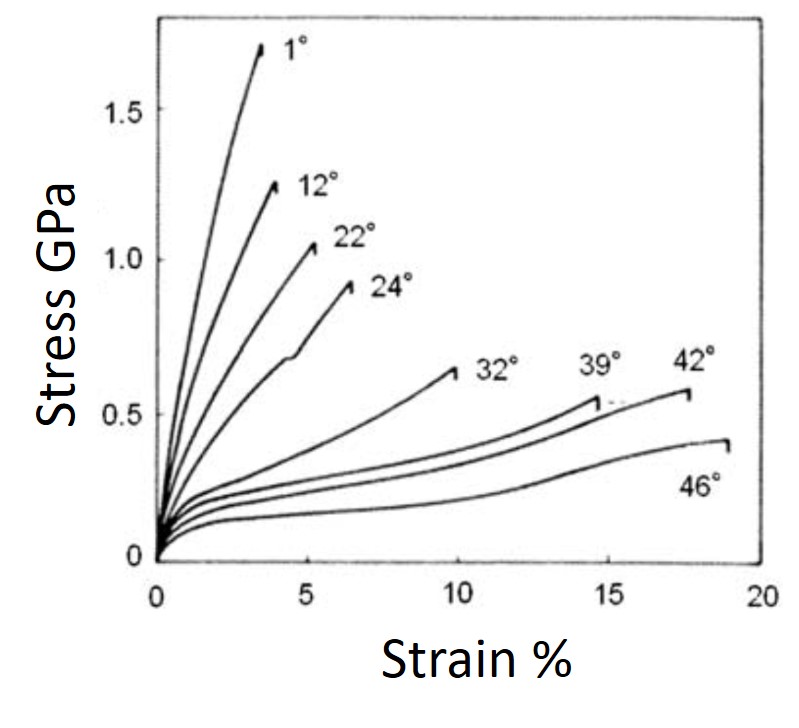 Original by Page in “Journal of Pulp and Paper Science” (1983) 99-100.
Original by Page in “Journal of Pulp and Paper Science” (1983) 99-100.
Q.11-6 What kind of experiment does the above graph show? (pick up a sentence)
Q.11-7 What do they mean in the values (1, 12, 22..)?
Q.11-8. Answer the results and conclusions from the graph. (pick up a sentence).
Here, I will introduce another dominance against the moisture. The below graph shows the longitudinal shrinkage in wood blocks with various MFAs. X-axis presents the MFAs in S2 layers. As shown in this graph, the larger MFA samples have higher shrinkage and the smaller MFA ones have smaller ones.
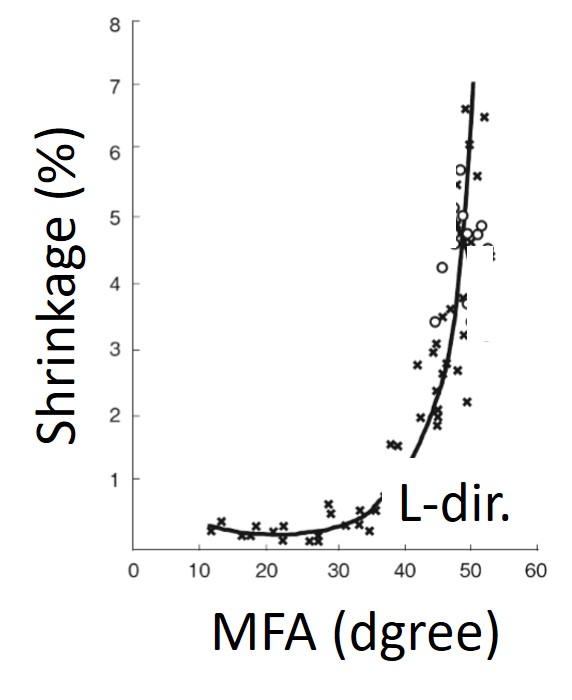 Original by Meylan in “Forest Products Journal” (1968) 75-78
Original by Meylan in “Forest Products Journal” (1968) 75-78
Q.11-9 What kind of experiment does the above graph show? (pick up a sentence)
These images explain the idea. Due to the hydrophilicity, the wood block shrinks its length under drying. Here, we set the two cell walls with small MFA (a) and large MFA (b) again. The cell walls has the same size and chemical compositions, but has different MFAs. When they are dried from the same moisture contents, the small MFA cell walls keep their shape, while the large MFA cell walls become shrink. These results presented that the cellulose microfibrils or MFAs in S2 layers dominate the mechanical property in wood blocks and pulp fibers.
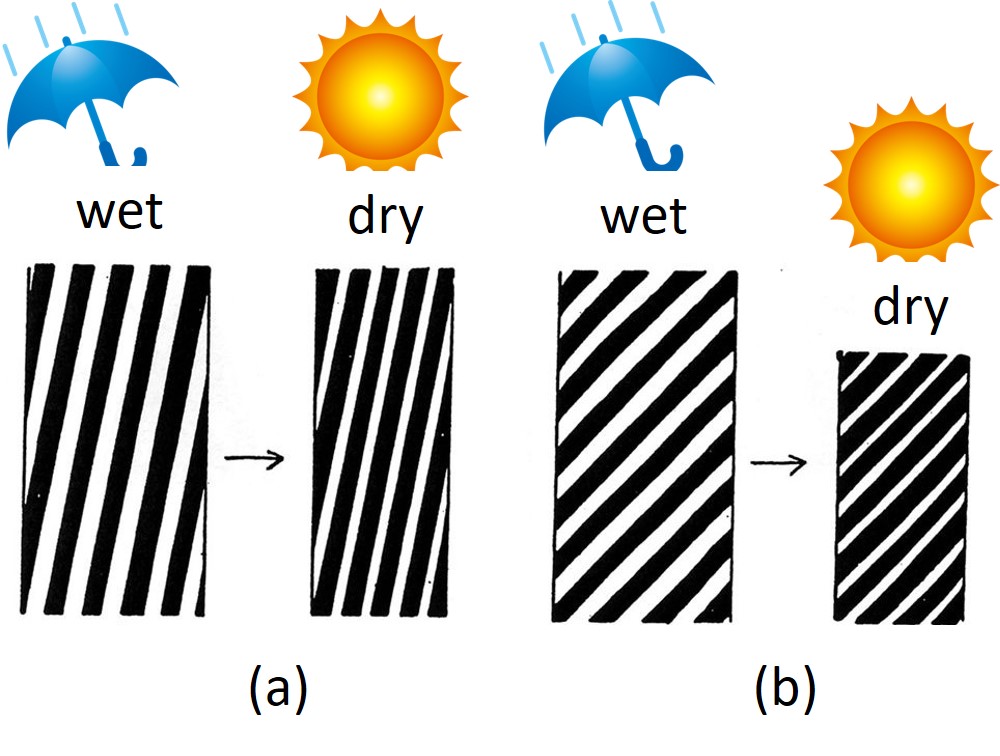
Q.11-10. Answer the conclusions from these. (pick up a sentence).
Section 12. The king dominates the world.

Bimetal is a material made by the bonding of two sheets or strips of different metals, each metal having a different coefficient of thermal expansion (CTE, 熱膨張率). Therefore, bimetal will be curved when they are heated (see the above). Many researchers have tried to develop such bilayered material, however the nature have already established in the plant “pine cone”.
Q.12-1 Answer the reason that the heated bimetal curls upwards in the above picture. (consider by yourself).
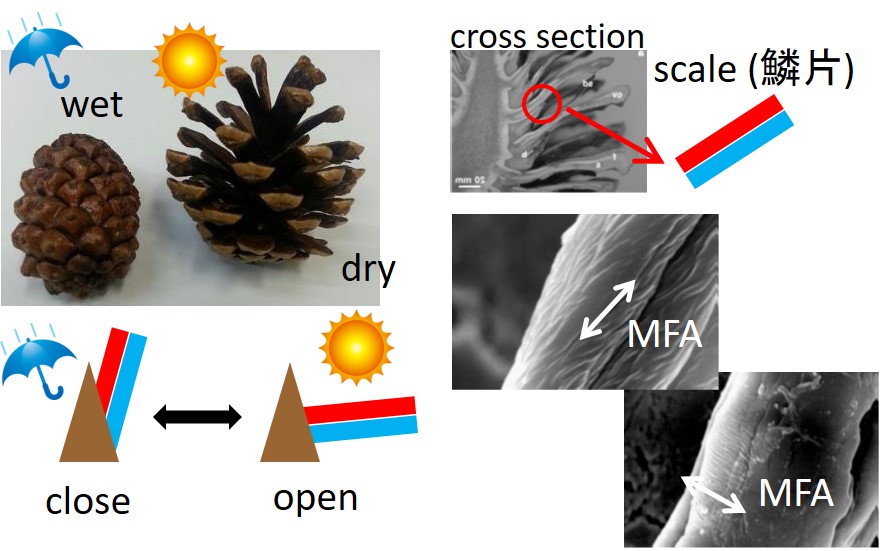
As you know the cone pines (松ぼっくり) close under the rain, while they open under the sunny, because their leaf of “scale (鱗片)” is bilayered materials. Of course, one side is larger MFA and other side smaller MFA. It was reported in Nature (1997). These findings tell you the cellulose microfibril is the cool !! And you will agree it is the king in the world, I hope so..
Q.12-2 In sunny day, which side have larger shrinkage ? Red side or blue side? (Consider by yourself)
Q.12-3 Which is larger MFA side in the scale? red or blue? Answer the reason, too. (Consider by yourself)
Overview
Answer these questions.
Q. O-0 Answer the hierarchical wood structure in (a)-(h).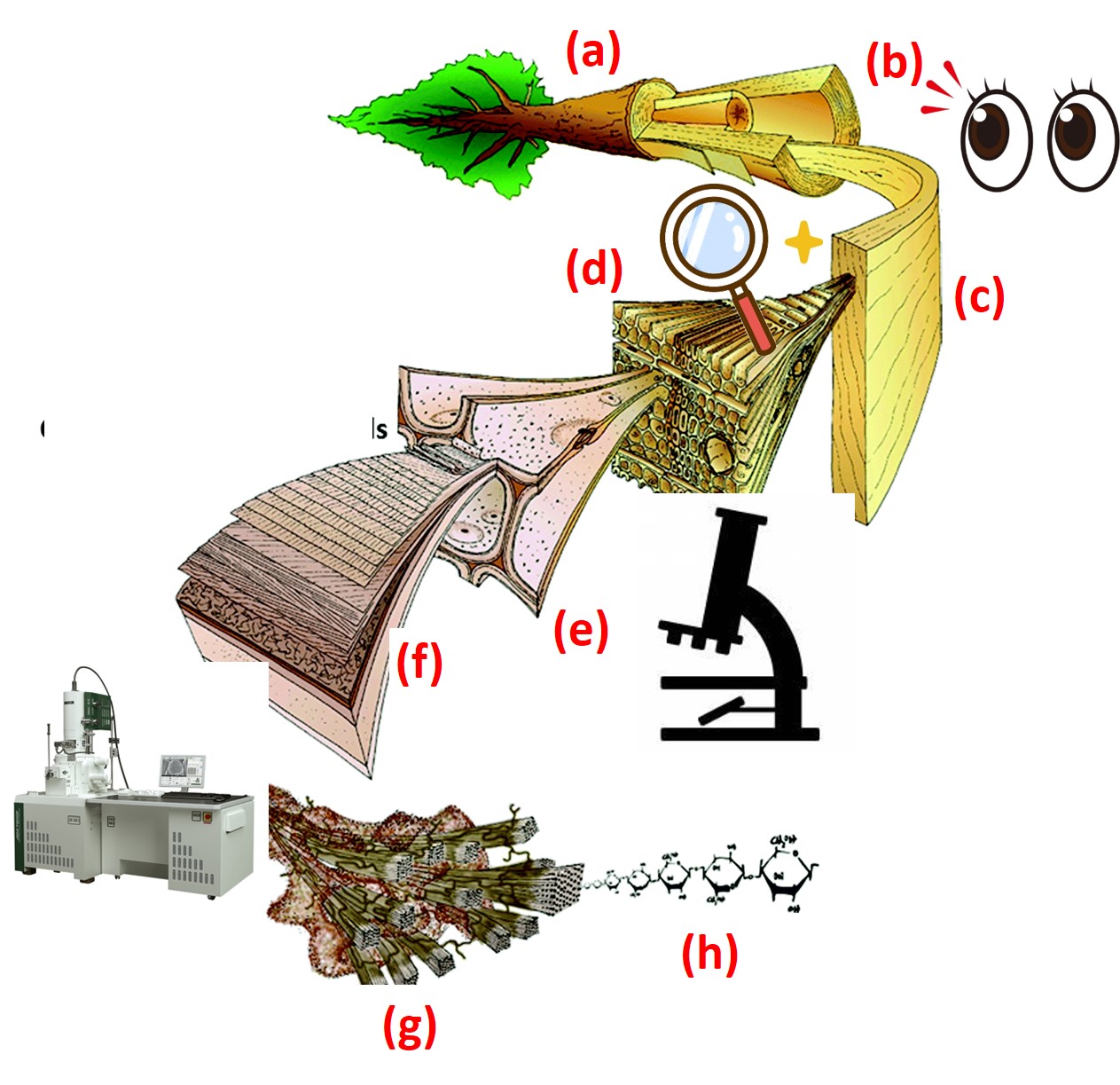
Q. O-1 Answer the three principle chemical composition in wood?
Q. O-2 Answer the orientation in the four layers (pick up a sentence)
Q. O-3 What is the MFA? (pick up a sentence)
Q. O-4 Answer the generation sequence in the cell wall. (pick up the sentence)
Q. O-5 Answer the two reasons that cellulose microfibril in S2 layer is the most important parameter in the wood cell.(pick up two sentences)
Q. O-6 Pick up each conclusion in the Page and Meylan’s experiments.
Q. O-7 Answer the reason how pine cone open in sunny day. (Consider by yourself).
Q. O-8 Answer the reason that nanopaper (ナノペーパー) has higher mechanical properties than the normal paper (普通紙), although the both consist of only the same cellulose nanofibers. (consider by yourself).
from here, under constructions..
[A. wood faces]
1. wood block is roughly wash with water or ethanol to remove the dust
2. the washed block was oven or air-dried
3. the sample was observed by the digital micro scope (KEYENCE)
https://www.keyence.co.jp/products/microscope/
4. wood has 3 faces of transverse, radial, and tangential section. So, you have to observe from the 3 angles of the transverse (TR, 柾目), the radial (R, 木口), and the tangential section (TA, 板目).
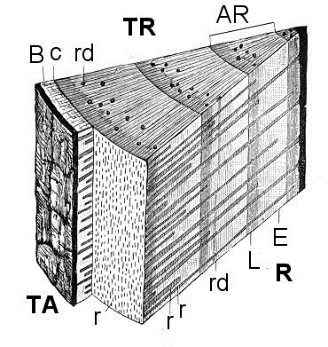
https://steurh.home.xs4all.nl/engconif/econhout.html
[A. homework]
1. Take three pictures at the lower magnification, which tell us the wood faces in the transverse (TR, 柾目), the radial (R, 木口), and the tangential section (TA, 板目).
2. You prepare the word file with the pictures and their directions. When you prepare it, don’t forget to reduce the file size.
http://www.nogimasaya.com/favorite/reduce/
[B. Microstructures]
1. use the same sample and microscope.
2. When you zoom up from 3 angles, you will find some typical wood structures as the below.
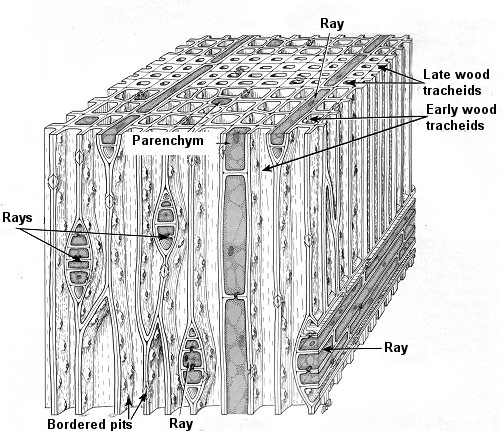
[B. homework]
1. At the higher manification, take three pictures from the each angles, which show some typical wood structures, such as the tracheids (仮道管), vessels (道管), pits (壁孔), ray (放射組織).
2. Search the name of your found typical structure, asking the google! Let’s try !!
3. Prepare the word file with the pictures and their name.
[C. pulp & nanostructures]
under constructions
© Department of Functionalized Natural Materials ISIR, Osaka University


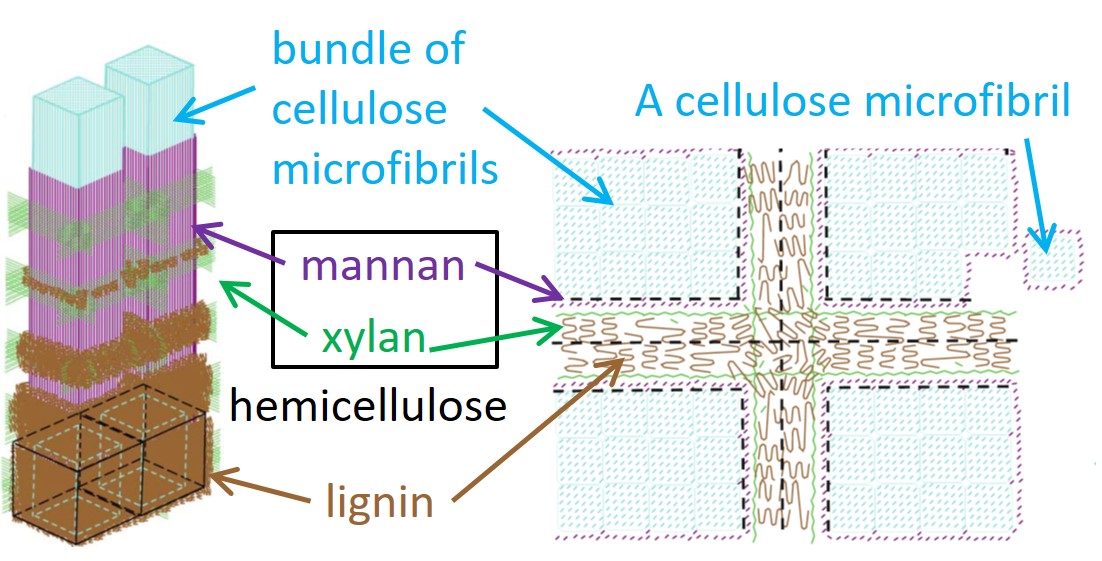 by
by 